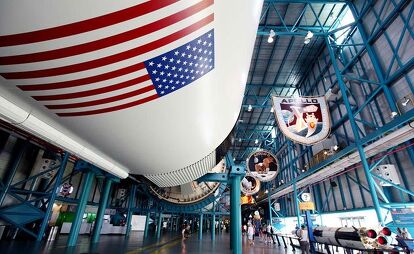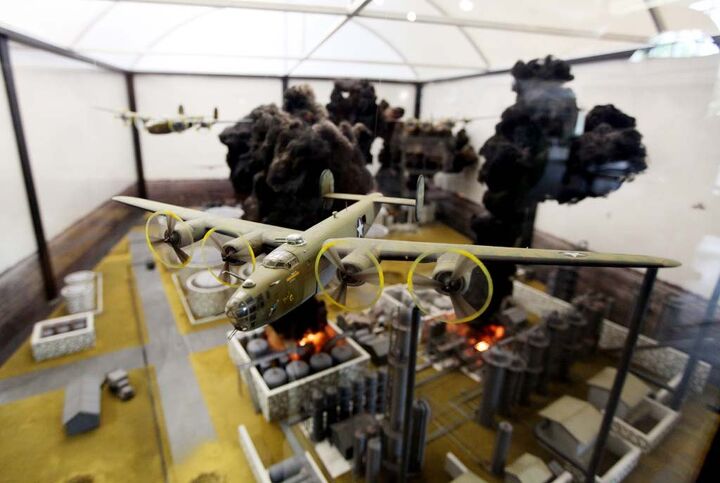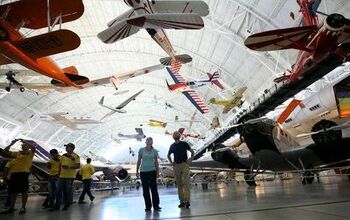The Wings Tour 2014: Leg Three + Video
This original Motorcycle.com editorial content was sponsored by American Honda.
“…let’s light this candle.”
–Alan Shepard to mission control moments before the launch of Freedom 7, which made him the first American in space.
Seven. Six. Five. Four. The space shuttle launch simulator begins to rattle and shake. Strapped into my seat and lying flat on my back, I brace for the artificial blast-off. We’ve reached the ultimate stop on our Wings Tour, Kennedy Space Center, where the cutting edge of flight takes place. A shudder and we’re off, make-believe hurling into outer space at 17,000 miles per hour.
This is the final installment of a three-part aviation-themed motorcycle tour aboard a 2014 Honda Gold Wing. If you missed the first two installments, they can be read here: Wings Tour: Leg One
Wings Tour: Leg Two
Day 5
It’s just a little under 800 miles from the Wright Brothers Memorial in North Carolina’s Outer Banks to the Kennedy Space Center in central Florida. That’s no Iron Butt record by any stretch of the imagination, but mileage alone doesn’t define an epic ride. Fifty miles on a mountain fire road trumps 500 miles on the interstate. One hour of riding in sub-freezing temperatures is more grueling than traveling 12 hours on a summer day.
Mother Nature gave us something to make Leg 3 one to remember. Once we hit I-95 it started to rain. And rain. And rain. Often when riding the interstates, rain only lasts a short time as you run into a shower that you quickly run out of. On this day, a storm front covered the entire East Coast and the rain clouds shadowed us all of the way to Florida.
We took a break from the wet ride to visit the National Museum of the Mighty Eighth Air Force, just off the interstate near Savannah. Dedicated to the exploits of the famous World War II bomber group, the museum seeks to impart the experience of making a bombing run over Europe.
I’ve never flown in combat over Germany, but I have been lucky enough to fly in a B-17 Flying Fortress. Exposed to the elements with the cold air pouring through the open gun ports, the smell and roar of 4,800 horsepower worth of Wright Cyclones almost drown out your inner thoughts. About as close as you can come to this is traveling a long distance by motorcycle. Hours spent fighting cold, boredom, fatigue, trying to stay sharp and keep your eyes scanning for danger, your ears tuned to the engine for any signs of trouble, nervously glancing at your fuel gauge, in the middle of nowhere and a long way from home.
A B-17 crew would spend 10 hours or more in the airplane on a bombing run. If they could make it back alive 25 times, they were able to go home, an accomplishment akin to running 25 stoplights in Manhattan during rush hour and coming out unscathed. As soon as the crews were over enemy territory, they were being shot at with high explosives and attacked by enemy fighters, nothing between them and the ground 20,000 feet below but a thin skin of sheet metal. Sounds a little bit like riding in heavy interstate traffic in the rain.
Spending hour after hour on the open road, we began to fully understand the Gold Wing‘s creature comforts. Long-distance riding is all about keeping the pilot in a state in which he can continue to ride. A good seat is the number-one priority. A nice, plush one with a back rest, like the Wing’s, goes a long way in keeping you in the saddle.
Minimizing exposure to the elements with the right gear and a well-designed fairing helps too. The bike’s fairing and windshield do a good job of keeping rider and passenger dry, slicing through the rain and creating a wind-tunnel bubble of dryness behind it. This works really well at 75 miles per hour. We didn’t stop to put on our rain gear and stayed perfectly dry in our mesh summer jackets. Then, as we reached Jacksonville, traffic ground to a halt. And it started to pour. Not a thunderstorm, but one of those floods of biblical proportions where you see the heavens opening up in front of you and a waterfall of rain tumbling towards the earth.
Don’t think you have any use for heated seats and grips in the summer? After our Jacksonville drenching, I cranked them up and opened the Gold Wing’s foot-warmer vents (little hatches that open up in front of the rider’s footpegs to direct warm air from the engine) to help dry out my gear. By the time we reached our stop for the night, soaking wet and several hours behind schedule, we were well past the point where the edge necessary to safely ride a motorcycle has been dulled.
Day 6
Central Florida is an aviation and aerospace mecca. From aerospace colleges, like Embry-Riddle, to Sun N’ Fun, the Daytona Bike Week of fly-ins, numerous warbird museums and the high-tech industries of Florida’s Space Coast, there’s always something in the air.
A1A. Cue Jimmy Buffett song of choice. This iconic Florida road files past beach bars and strip clubs, crab shacks and hot dog stands through almost every beach town on Florida’s east coast. You can’t ride in Florida without taking a trip down A1A. We jumped off the interstate to continue our tour, stopping in St. Augustine to visit the old Spanish fort.
We chose to make the final stop of our Wings Tour a visit to the Kennedy Space Center, the pinnacle of the aerospace industry. Our tour had taken us from the place where the Wright brothers launched their 152-foot first flight to the spot where three men were blasted 238,000 miles into space to land on the moon. Many of the roads leading into the Space Center have been designated Florida Scenic Highways. The Center itself is in the middle of the 140,000-acre Merritt Island National Wildlife Refuge, and as you ride along there are alligators in the canals, with deer and wild hogs standing on the banks.
Like the Mighty Eighth museum, Kennedy Space Center’s Visitor Complex works hard to impart the experience of flight, from simulators that mimic what it’s like to land a space shuttle to one that gives the sensation of sitting on half-a-million gallons of fuel and two rockets when they are ignited. More than a museum, the Kennedy Space Center is a celebration of the accomplishments of those who ignored the critics, attacked the impossible and succeeded.
And then, standing amongst the space suits and rocket ships, it struck me. The connection between motorcycles and flying machines isn’t about motors and fuel. It’s not about high speeds or complex technology. We are fascinated by motorcycles and airplanes not for what they are but for what they represent. They are dream machines, the vehicles on which we launch our hopes and aspirations. When we commute to work on a motorcycle, we always know that we’re one turn away from adventure. When we sit at the airport waiting for our flight, staring out the window at the hundreds of planes sitting on the tarmac, each one represents a journey, a destination. We are drawn to machines like motorcycles and airplanes because they hold the romance of the unknown, the endless possibilities enshrined in a fleeting horizon.
Flight Log: Leg Three |
|---|
| Total Hours Riding, Leg Three: 13 hours Total Miles, Leg Three: 878 miles Average Fuel Consumption: (mix of urban, interstate and coastal roads): 41 mpg |
Wings Tour Flight Log |
| Total Hours Riding: 32 hours Total Trip Miles: 1,638 miles States Traveled In: Maryland, Virginia, North Carolina, South Carolina, Georgia, Florida Best Fuel Mileage of the Trip: 45 mpg (I-95 Interstate) Worst Fuel Mileage of the Trip: 30 mpg (D.C. metro traffic) Total Wings Eaten: 6 |
When Jack Nicholson flaps his arms like a bird on the back seat of Peter Fonda’s Harley in Easy Rider, it’s because he just realized that he doesn’t know what he’ll eat for dinner, where he’ll sleep that night or what tomorrow will hold. That exuberance is the feeling that motorcycles and airplanes give us.
As I stood in the place that celebrates some of our greatest accomplishments of the 20th century and marks our hopes for a future in which less and less of the universe is beyond our grasp I thought of the ending lines of Thom Gunn’s poem On the Move:
At worse, one is in motion; and at best
Reaching no absolute, in which to rest
One is always nearer by not keeping still.
This original Motorcycle.com editorial content was sponsored by American Honda.
More by Jeremiah Knupp

















































































































Comments
Join the conversation